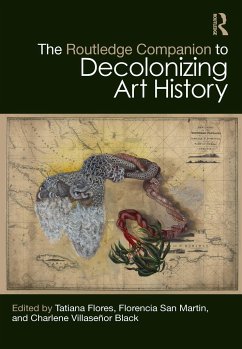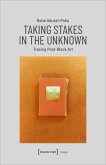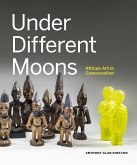The Routledge Companion to Decolonizing Art History
Herausgeber: Villasenor Black, Charlene; Flores, Tatiana; San Martin, Florencia
The Routledge Companion to Decolonizing Art History
Herausgeber: Villasenor Black, Charlene; Flores, Tatiana; San Martin, Florencia
- Gebundenes Buch
- Merkliste
- Auf die Merkliste
- Bewerten Bewerten
- Teilen
- Produkt teilen
- Produkterinnerung
- Produkterinnerung
This companion is the first global, comprehensive text to explicate, theorize and propose decolonial methodologies for art historians, museum professionals, artists, and other visual culture scholars, teachers, and practitioners.
Andere Kunden interessierten sich auch für
![The Routledge Handbook of Classics, Colonialism, and Postcolonial Theory The Routledge Handbook of Classics, Colonialism, and Postcolonial Theory]() The Routledge Handbook of Classics, Colonialism, and Postcolonial Theory272,99 €
The Routledge Handbook of Classics, Colonialism, and Postcolonial Theory272,99 €![The Primitivist Imaginary in Iberian and Transatlantic Modernisms The Primitivist Imaginary in Iberian and Transatlantic Modernisms]() The Primitivist Imaginary in Iberian and Transatlantic Modernisms164,99 €
The Primitivist Imaginary in Iberian and Transatlantic Modernisms164,99 €![Museums in Postcolonial Europe Museums in Postcolonial Europe]() Museums in Postcolonial Europe202,99 €
Museums in Postcolonial Europe202,99 €![Taking Stakes in the Unknown Taking Stakes in the Unknown]() Nana Adusei-PokuTaking Stakes in the Unknown26,99 €
Nana Adusei-PokuTaking Stakes in the Unknown26,99 €![Under Different Moons Under Different Moons]() Anthony Alan SheltonUnder Different Moons43,99 €
Anthony Alan SheltonUnder Different Moons43,99 €![The Routledge Companion to Big History The Routledge Companion to Big History]() The Routledge Companion to Big History311,99 €
The Routledge Companion to Big History311,99 €![The Victorian Idyll in Art and Literature The Victorian Idyll in Art and Literature]() The Victorian Idyll in Art and Literature166,99 €
The Victorian Idyll in Art and Literature166,99 €-
-
-
This companion is the first global, comprehensive text to explicate, theorize and propose decolonial methodologies for art historians, museum professionals, artists, and other visual culture scholars, teachers, and practitioners.
Hinweis: Dieser Artikel kann nur an eine deutsche Lieferadresse ausgeliefert werden.
Hinweis: Dieser Artikel kann nur an eine deutsche Lieferadresse ausgeliefert werden.
Produktdetails
- Produktdetails
- Verlag: Taylor & Francis Ltd
- Seitenzahl: 610
- Erscheinungstermin: 27. November 2023
- Englisch
- Abmessung: 246mm x 174mm
- Gewicht: 1800g
- ISBN-13: 9780367714819
- ISBN-10: 0367714817
- Artikelnr.: 68474584
- Herstellerkennzeichnung
- Libri GmbH
- Europaallee 1
- 36244 Bad Hersfeld
- 06621 890
- Verlag: Taylor & Francis Ltd
- Seitenzahl: 610
- Erscheinungstermin: 27. November 2023
- Englisch
- Abmessung: 246mm x 174mm
- Gewicht: 1800g
- ISBN-13: 9780367714819
- ISBN-10: 0367714817
- Artikelnr.: 68474584
- Herstellerkennzeichnung
- Libri GmbH
- Europaallee 1
- 36244 Bad Hersfeld
- 06621 890
Tatiana Flores is Jefferson Scholars Foundation Edgar F. Shannon Professor of Art History at the University of Virginia. Florencia San Martín is an assistant professor of Art History in the Department of Art, Architecture and Design at Lehigh University. Charlene Villaseñor Black is chair of the César E. Chávez Department of Chicana/o and Central American Studies and professor of Art History at the University of California, Los Angeles, editor of Aztlán: A Journal of Chicano Studies, and founding editor-in-chief of Latin American and Latinx Visual Culture.
SECTION I: INTRODUCTION SECTION II: BEING AND DOING 1. Writing Art History
in the Age of Black Lives Matter 2. Being an Indigenous Art Historian in
the 21st Century: How can M¿ori Adornment Reveal New Ways of Thinking about
Art, its Histories, and Futures 3. Reinvention at the Wheel: Shaping New
Histories in the Decolonization of Disability 4.The Power of Absence: An
Interview with Ken Gonzales-Day 5.Art in Paradise Found and Lost 6.The
Maquette -Modèles of Bodys Isek Kingelez: Envisioning Decolonial Monuments
7. Decolonizing La Revolución: Cuban Artistic Practice in a Liminal Space
8. Museums are Temples of Whiteness 9. Stepping out of the Shadow of
Imperial Monochrony: A Place-centric Approach to Decolonizing Japanese Art
History 10. On Failure and the Nation State: A Decolonial Reading of
Alfredo Jaar's A Logo for America 11. Light as a Feather: The
Anti-capitalist Radiance of Decolonial Art History SECTION III: LEARNING
AND LISTENING 12. Where's Decolonization? The Ohketeau Cultural Center,
Indigenous Sovereignty, and Arts Institutions 13. Overcoming Art History's
Meta-Narrative 14. Pathways to Art History: Pedagogy, Research, and Praxis
through a Decolonial Lens 15. Pedagogies of Place: Listening and Learning
in the Margins 16. The Unbearable Lightness of Adjuncting Art History 17.
Decolonial Cinematic Flows: Histories, Movements, Confluences 18.
Re-Indigenizing Ancient Mexican Glyphic Codices 19. (Not) Performing
Pasifika Indigeneity: Destabilizing the Researcher as Decolonizing Method
in Art History 20. Afterlives/Futurelives: Imagining Mermaids and recalling
Ghost Dancing 21. Decolonizing California Mission Art and Architecture
Studies 22.SECTION IV: SENSING AND SEEING 23. Spooky Art History (or,
Whatever Happened to the Postcolonial?) 24. Spatial Abstraction as a
Colonizing Tool 25. Dishumanizing Art History? 26.The Digital Voice as
Postcolonial Proxy 27. Reflecting on Whiteness in Recent Contemporary
Artwork Exploring Transnational Poland 28. Racialization, Creolization, and
Minor Transnationalism: Black and Indigenous Exchange in Spanish Colonial
Visual Culture 29. The Imperial Landscape of 18th-Century Anglo-Indian
Portraiture 30. Unseeing Art History: Inca Material Culture 31. Debility
and the Ethics of Proximity: Spatial and Temporal Immediacy in the Work of
Candice Lin 32. Decolonizing Crocodiles, Repatriating Birds:Human-Animal
Relations in the Historical Indian Landscape 33. "We are so many bodies, my
friends": Countervisibility as Resurgent Tactics SECTION V: LIVING AND
LOVING 34. "she carried with her...a large bundle of wearing apparel
belonging to herself": Slave Dress as Resistance in Portraiture and
Fugitive Slave Advertisements 3 5. Rina Banerjee's Decolonial Ecologies
36.The Teaching is in the Making: A Relational and Embodied Experience of
Anishinaabe Photographs 37. Reflections on a Latinx Decolonial Praxis for
Medievalists 38. The Waters Surrounding Wallmapu, the Waters Surrounding
Life 39. Dialogical Episodes for Decolonizing (Art) History 40. Inner
Spaces: The Depth Imagination 41. Maria Auxiliadora da Silva: Nossa Mãe
Maria of Terreiro Life and Faith on Black Grounds 42. Michael Richards:
Performance as Ritual and Black-Indigenous Haptic Visuality 43. Bittersweet
Histories and Tarnished Gold: Slavery's Sounds, Sights and Silences in the
Legacy of Dutch Brazil 44. A Personal Take, or Stuck in the Middle/Side and
Going Nowhere: An Attempt at Imagining a Methodology for Engaging Colonial
Photographic Archives, Histories, and Subjectivities SECTION VI: AFTERWORD
45. Towards a Combative Decolonial Aesthetics
in the Age of Black Lives Matter 2. Being an Indigenous Art Historian in
the 21st Century: How can M¿ori Adornment Reveal New Ways of Thinking about
Art, its Histories, and Futures 3. Reinvention at the Wheel: Shaping New
Histories in the Decolonization of Disability 4.The Power of Absence: An
Interview with Ken Gonzales-Day 5.Art in Paradise Found and Lost 6.The
Maquette -Modèles of Bodys Isek Kingelez: Envisioning Decolonial Monuments
7. Decolonizing La Revolución: Cuban Artistic Practice in a Liminal Space
8. Museums are Temples of Whiteness 9. Stepping out of the Shadow of
Imperial Monochrony: A Place-centric Approach to Decolonizing Japanese Art
History 10. On Failure and the Nation State: A Decolonial Reading of
Alfredo Jaar's A Logo for America 11. Light as a Feather: The
Anti-capitalist Radiance of Decolonial Art History SECTION III: LEARNING
AND LISTENING 12. Where's Decolonization? The Ohketeau Cultural Center,
Indigenous Sovereignty, and Arts Institutions 13. Overcoming Art History's
Meta-Narrative 14. Pathways to Art History: Pedagogy, Research, and Praxis
through a Decolonial Lens 15. Pedagogies of Place: Listening and Learning
in the Margins 16. The Unbearable Lightness of Adjuncting Art History 17.
Decolonial Cinematic Flows: Histories, Movements, Confluences 18.
Re-Indigenizing Ancient Mexican Glyphic Codices 19. (Not) Performing
Pasifika Indigeneity: Destabilizing the Researcher as Decolonizing Method
in Art History 20. Afterlives/Futurelives: Imagining Mermaids and recalling
Ghost Dancing 21. Decolonizing California Mission Art and Architecture
Studies 22.SECTION IV: SENSING AND SEEING 23. Spooky Art History (or,
Whatever Happened to the Postcolonial?) 24. Spatial Abstraction as a
Colonizing Tool 25. Dishumanizing Art History? 26.The Digital Voice as
Postcolonial Proxy 27. Reflecting on Whiteness in Recent Contemporary
Artwork Exploring Transnational Poland 28. Racialization, Creolization, and
Minor Transnationalism: Black and Indigenous Exchange in Spanish Colonial
Visual Culture 29. The Imperial Landscape of 18th-Century Anglo-Indian
Portraiture 30. Unseeing Art History: Inca Material Culture 31. Debility
and the Ethics of Proximity: Spatial and Temporal Immediacy in the Work of
Candice Lin 32. Decolonizing Crocodiles, Repatriating Birds:Human-Animal
Relations in the Historical Indian Landscape 33. "We are so many bodies, my
friends": Countervisibility as Resurgent Tactics SECTION V: LIVING AND
LOVING 34. "she carried with her...a large bundle of wearing apparel
belonging to herself": Slave Dress as Resistance in Portraiture and
Fugitive Slave Advertisements 3 5. Rina Banerjee's Decolonial Ecologies
36.The Teaching is in the Making: A Relational and Embodied Experience of
Anishinaabe Photographs 37. Reflections on a Latinx Decolonial Praxis for
Medievalists 38. The Waters Surrounding Wallmapu, the Waters Surrounding
Life 39. Dialogical Episodes for Decolonizing (Art) History 40. Inner
Spaces: The Depth Imagination 41. Maria Auxiliadora da Silva: Nossa Mãe
Maria of Terreiro Life and Faith on Black Grounds 42. Michael Richards:
Performance as Ritual and Black-Indigenous Haptic Visuality 43. Bittersweet
Histories and Tarnished Gold: Slavery's Sounds, Sights and Silences in the
Legacy of Dutch Brazil 44. A Personal Take, or Stuck in the Middle/Side and
Going Nowhere: An Attempt at Imagining a Methodology for Engaging Colonial
Photographic Archives, Histories, and Subjectivities SECTION VI: AFTERWORD
45. Towards a Combative Decolonial Aesthetics
SECTION I: INTRODUCTION SECTION II: BEING AND DOING 1. Writing Art History
in the Age of Black Lives Matter 2. Being an Indigenous Art Historian in
the 21st Century: How can M¿ori Adornment Reveal New Ways of Thinking about
Art, its Histories, and Futures 3. Reinvention at the Wheel: Shaping New
Histories in the Decolonization of Disability 4.The Power of Absence: An
Interview with Ken Gonzales-Day 5.Art in Paradise Found and Lost 6.The
Maquette -Modèles of Bodys Isek Kingelez: Envisioning Decolonial Monuments
7. Decolonizing La Revolución: Cuban Artistic Practice in a Liminal Space
8. Museums are Temples of Whiteness 9. Stepping out of the Shadow of
Imperial Monochrony: A Place-centric Approach to Decolonizing Japanese Art
History 10. On Failure and the Nation State: A Decolonial Reading of
Alfredo Jaar's A Logo for America 11. Light as a Feather: The
Anti-capitalist Radiance of Decolonial Art History SECTION III: LEARNING
AND LISTENING 12. Where's Decolonization? The Ohketeau Cultural Center,
Indigenous Sovereignty, and Arts Institutions 13. Overcoming Art History's
Meta-Narrative 14. Pathways to Art History: Pedagogy, Research, and Praxis
through a Decolonial Lens 15. Pedagogies of Place: Listening and Learning
in the Margins 16. The Unbearable Lightness of Adjuncting Art History 17.
Decolonial Cinematic Flows: Histories, Movements, Confluences 18.
Re-Indigenizing Ancient Mexican Glyphic Codices 19. (Not) Performing
Pasifika Indigeneity: Destabilizing the Researcher as Decolonizing Method
in Art History 20. Afterlives/Futurelives: Imagining Mermaids and recalling
Ghost Dancing 21. Decolonizing California Mission Art and Architecture
Studies 22.SECTION IV: SENSING AND SEEING 23. Spooky Art History (or,
Whatever Happened to the Postcolonial?) 24. Spatial Abstraction as a
Colonizing Tool 25. Dishumanizing Art History? 26.The Digital Voice as
Postcolonial Proxy 27. Reflecting on Whiteness in Recent Contemporary
Artwork Exploring Transnational Poland 28. Racialization, Creolization, and
Minor Transnationalism: Black and Indigenous Exchange in Spanish Colonial
Visual Culture 29. The Imperial Landscape of 18th-Century Anglo-Indian
Portraiture 30. Unseeing Art History: Inca Material Culture 31. Debility
and the Ethics of Proximity: Spatial and Temporal Immediacy in the Work of
Candice Lin 32. Decolonizing Crocodiles, Repatriating Birds:Human-Animal
Relations in the Historical Indian Landscape 33. "We are so many bodies, my
friends": Countervisibility as Resurgent Tactics SECTION V: LIVING AND
LOVING 34. "she carried with her...a large bundle of wearing apparel
belonging to herself": Slave Dress as Resistance in Portraiture and
Fugitive Slave Advertisements 3 5. Rina Banerjee's Decolonial Ecologies
36.The Teaching is in the Making: A Relational and Embodied Experience of
Anishinaabe Photographs 37. Reflections on a Latinx Decolonial Praxis for
Medievalists 38. The Waters Surrounding Wallmapu, the Waters Surrounding
Life 39. Dialogical Episodes for Decolonizing (Art) History 40. Inner
Spaces: The Depth Imagination 41. Maria Auxiliadora da Silva: Nossa Mãe
Maria of Terreiro Life and Faith on Black Grounds 42. Michael Richards:
Performance as Ritual and Black-Indigenous Haptic Visuality 43. Bittersweet
Histories and Tarnished Gold: Slavery's Sounds, Sights and Silences in the
Legacy of Dutch Brazil 44. A Personal Take, or Stuck in the Middle/Side and
Going Nowhere: An Attempt at Imagining a Methodology for Engaging Colonial
Photographic Archives, Histories, and Subjectivities SECTION VI: AFTERWORD
45. Towards a Combative Decolonial Aesthetics
in the Age of Black Lives Matter 2. Being an Indigenous Art Historian in
the 21st Century: How can M¿ori Adornment Reveal New Ways of Thinking about
Art, its Histories, and Futures 3. Reinvention at the Wheel: Shaping New
Histories in the Decolonization of Disability 4.The Power of Absence: An
Interview with Ken Gonzales-Day 5.Art in Paradise Found and Lost 6.The
Maquette -Modèles of Bodys Isek Kingelez: Envisioning Decolonial Monuments
7. Decolonizing La Revolución: Cuban Artistic Practice in a Liminal Space
8. Museums are Temples of Whiteness 9. Stepping out of the Shadow of
Imperial Monochrony: A Place-centric Approach to Decolonizing Japanese Art
History 10. On Failure and the Nation State: A Decolonial Reading of
Alfredo Jaar's A Logo for America 11. Light as a Feather: The
Anti-capitalist Radiance of Decolonial Art History SECTION III: LEARNING
AND LISTENING 12. Where's Decolonization? The Ohketeau Cultural Center,
Indigenous Sovereignty, and Arts Institutions 13. Overcoming Art History's
Meta-Narrative 14. Pathways to Art History: Pedagogy, Research, and Praxis
through a Decolonial Lens 15. Pedagogies of Place: Listening and Learning
in the Margins 16. The Unbearable Lightness of Adjuncting Art History 17.
Decolonial Cinematic Flows: Histories, Movements, Confluences 18.
Re-Indigenizing Ancient Mexican Glyphic Codices 19. (Not) Performing
Pasifika Indigeneity: Destabilizing the Researcher as Decolonizing Method
in Art History 20. Afterlives/Futurelives: Imagining Mermaids and recalling
Ghost Dancing 21. Decolonizing California Mission Art and Architecture
Studies 22.SECTION IV: SENSING AND SEEING 23. Spooky Art History (or,
Whatever Happened to the Postcolonial?) 24. Spatial Abstraction as a
Colonizing Tool 25. Dishumanizing Art History? 26.The Digital Voice as
Postcolonial Proxy 27. Reflecting on Whiteness in Recent Contemporary
Artwork Exploring Transnational Poland 28. Racialization, Creolization, and
Minor Transnationalism: Black and Indigenous Exchange in Spanish Colonial
Visual Culture 29. The Imperial Landscape of 18th-Century Anglo-Indian
Portraiture 30. Unseeing Art History: Inca Material Culture 31. Debility
and the Ethics of Proximity: Spatial and Temporal Immediacy in the Work of
Candice Lin 32. Decolonizing Crocodiles, Repatriating Birds:Human-Animal
Relations in the Historical Indian Landscape 33. "We are so many bodies, my
friends": Countervisibility as Resurgent Tactics SECTION V: LIVING AND
LOVING 34. "she carried with her...a large bundle of wearing apparel
belonging to herself": Slave Dress as Resistance in Portraiture and
Fugitive Slave Advertisements 3 5. Rina Banerjee's Decolonial Ecologies
36.The Teaching is in the Making: A Relational and Embodied Experience of
Anishinaabe Photographs 37. Reflections on a Latinx Decolonial Praxis for
Medievalists 38. The Waters Surrounding Wallmapu, the Waters Surrounding
Life 39. Dialogical Episodes for Decolonizing (Art) History 40. Inner
Spaces: The Depth Imagination 41. Maria Auxiliadora da Silva: Nossa Mãe
Maria of Terreiro Life and Faith on Black Grounds 42. Michael Richards:
Performance as Ritual and Black-Indigenous Haptic Visuality 43. Bittersweet
Histories and Tarnished Gold: Slavery's Sounds, Sights and Silences in the
Legacy of Dutch Brazil 44. A Personal Take, or Stuck in the Middle/Side and
Going Nowhere: An Attempt at Imagining a Methodology for Engaging Colonial
Photographic Archives, Histories, and Subjectivities SECTION VI: AFTERWORD
45. Towards a Combative Decolonial Aesthetics








